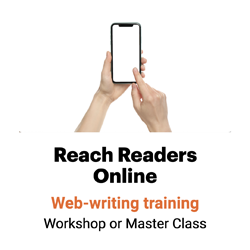Put the hot stuff up top with the 1-2-3-4 test
Web visitors spend 74% of their time on the first two screens, just 26% on all remaining screens, according to the Nielsen Norman Group

So don’t blow your top.
To reach mobile web visitors up top, communicate the gist of the message in the first four elements of the web page:
1. Headline
Tell the story, don’t tell about the story. “Hallmark doubles profit-sharing contribution,” for instance, not “Benefits changes announced.”
And don’t even get me started on label headlines: “Benefits changes” is not a headline.
Before:
Preventing and declaring conflicts of interest
This buries the topic behind 25 characters worth of –inging words. Plus, it’s unclear: Who’s preventing? Who’s declaring?
After:
Conflicts of interest: How do you handle?
This moves the topic to the top and clarifies who’s responsible.
2. Deck.
Deliver a secondary angle for news stories and a summary for benefits and feature stories. Don’t drop this essential element: 95% of web page visitors look at the deck.
Before: The writer dropped the deck, missing 25% of her chance to get the word out within the top four elements of the story.
After:
Conduct all your business ethically with our new policy
The new deck adds the benefit to the readers and introduces the new policy.
3. Lead
Show, don’t tell. Leads that illustrate the point with concrete material like stories bring the point to life for readers. And they draw 300% more readers and 520% more reading, according to a split test by Alex Turnbull and the Groove HQ.
Before:
Have you ever been in a situation where your personal interests seem to be in conflict with your responsibilities as an XYZ employee?
I think I’d read 520% more of this if it were 15% more colorful.
After:
Is your brother-in-law bidding on an XYZ contract? Does your husband work for the competition? Is your neighbor applying for a job in your department?
Just a light touch of detail makes this piece more engaging, puts the reader in the story and brings the message to life.
4. Nut graph
Put the story into a nutshell in the second paragraph. Don’t drop the deck: 95% of web page visitors read the deck, so it’s a key element for communicating to skimmers and other nonreaders in a hurry.
Before:
Situations such as these can touch every aspect of our day-to-day operations, regardless of where we are located or what we do. They can be difficult to identify and it may not always be clear how best to resolve them.
I’m sure this is all true, but it doesn’t define the story and move it forward. I’d consider this background rather than a nut graph.
After:
If so, your personal interests may be in conflict with your responsibilities as an XYZ employee. Our new conflicts of interest policy can help.
Here, we make the story snappier and get that policy link up among the first four elements.
Now test it.
Now email those first four elements to yourself and test them on your smartphone.
Before |
After |
Preventing and declaring conflicts of interestHave you ever been in a situation where your personal interests seem to be in conflict with your responsibilities as an XYZ employee? Situations such as these can touch every aspect of our day-to-day operations, regardless of where we are located or what we do. They can be difficult to identify and it may not always be clear how best to resolve them. |
Conflicts of interest: How do you handle?Conduct all your business ethically with our new policyIs your brother-in-law bidding on an XYZ contract? Does your husband work for the competition? Is your neighbor applying for a job in your department? If so, your personal interests may be in conflict with your responsibilities as an XYZ employee. Our new conflicts of interest policy can help. |
Can you get the gist of the story from the first four elements? If so, congratulations! You pass the 1-2-3-4 test.

Leave a Reply